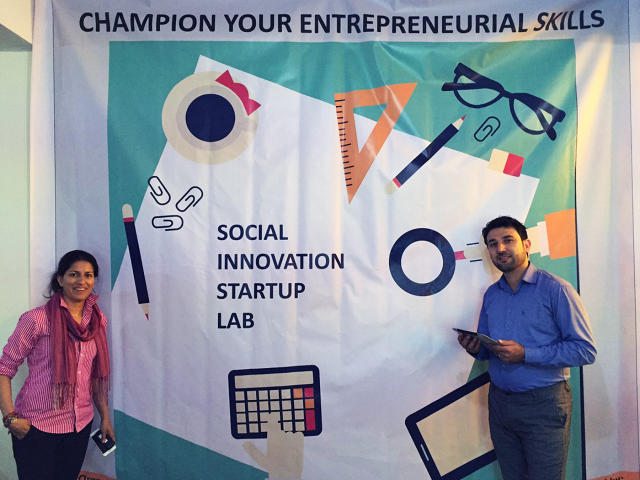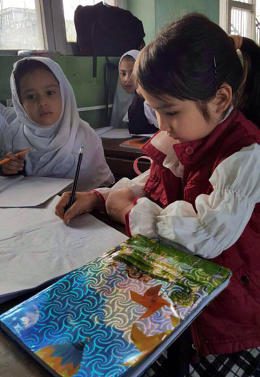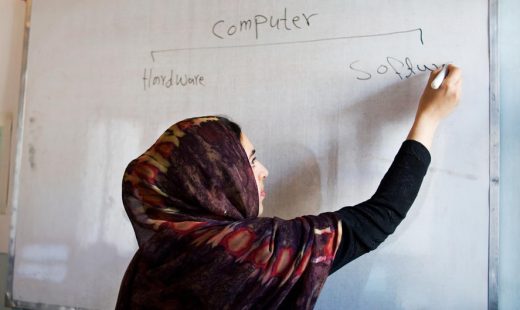This Is What It’s Like For Female Entrepreneurs In Afghanistan
It’s been 15 years since U.S. forces invaded Afghanistan. In the capital city of Kabul—the world’s fifth-fastest-growing urban population, which jumped from half a million in 2001 to over 4.6 million—the Afghan government struggles against a worsening humanitarian situation. As U.S. and NATO troops continue to withdraw, so do international aid workers.
Typically, the burden of international problems such as poverty, disaster, and war are left exclusively to governments and nonprofit organizations. In recent years, a new approach has emerged. Social entrepreneurs are spearheading job growth and stability, and a burgeoning private sector seeks to stabilize the economy and break the dependency on foreign aid.
They walk a fragile line. They must build networks with trusted government workers, the international business community, young students, and professionals. Many Afghan business leaders hope to attract investors who will bet on them to secure hard-won gains in human rights, especially for women.

Shetab Afghanistan, which translates to “accelerator” in Persian/Dari, is a newly launched incubator and coworking space offering mentoring and acceleration services for social innovators, activists, and entrepreneurs. Founders Ajmal Paiman and Azadeh Tajdar launched their first lab to support six startups this September. This included the first female participant in Shetab’s emerging network, a country ranked to be the most oppressive in the world for girls and women.
“Afghanistan has a nascent women-led startup scene, and women need more encouragement and incentives to actually consider the entrepreneurial option, particularly in the Afghan context, where formal employment opportunities for women are limited,” explains Tajdar. “The more successful female entrepreneurs emerge in Afghanistan, the more society will leap forward.”
According to the U.N., the World Bank, and other organizations, when women have access to education, jobs, and leadership positions, communities and nations benefit.
But there are significant challenges. estimates that almost nine out of 10 Afghan women face physical, sexual, or psychological violence or are forced into marriage. As in many countries, Afghan girls tend to drop out in secondary school due to cultural barriers, including early marriage practices. The United Nations Population Fund estimates that 46% of Afghan girls are married by age 18, and 15% of them are married before age 15.
The country has the highest gender disparity in the world for primary education: 71 girls attend for every 100 boys. Only 21% of these girls end up completing primary school. According to experts and women across the war-torn country, little has changed for women there, despite upwards of $1.5 billion spent to empower women and girls. But could supporting women-led initiatives and startups ensure intervention programs run as intended?

“Entrepreneurship also empowers, enabling a poor woman in a poor country to generate income, secure a good home, and send her children to school,” states Steven Koltai, who helped lead the creation of the Global Entrepreneurship Program under former Secretary of State Hillary Clinton. “This is also the promise of microfinance, but full-blown entrepreneurship takes it to a meaningful, lasting level,” he says. Koltai sees entrepreneurship as the first step up the economic ladder, “providing access to both well-being and social respect for those who are normally denied such access, including women, ethnic minorities, and those lacking friends in high places.”
Over the course of two years, Koltai acted as senior adviser to the Global Entrepreneurship Program and oversaw the launch of pilot projects across the Middle East. For Koltai, “There’s a straight-line connection between unemployment, and political instability and unrest.” Fostering entrepreneurship is the remedy.
Koltai believes that the U.S. government should be spending more money to support entrepreneurs. “I’d like to see it shift its international economic development resources—even slightly—so that more U.S. aid dollars are directed to bolstering the entrepreneurship ecosystems that are essential to nurturing startups,” he says.
Afghan President Ashraf Ghani expressed a similar view in his TEDGlobal talk, “How to Rebuild a Broken State.” He urged the importance of global engagement in the region, but stressed, “Instead of sending $100 billion in aid, send the money to the most innovative companies.” Ghani echoed this in his inaugural speech in 2014, referring to it as a “triangle of stability” whose three sides are the economy, security, and human resources. His leadership aims to stimulate the private sector by attracting foreign investors as traditional aid dries up.
To date, the U.S. has spent over $850 billion in Afghanistan. Of that money, roughly $218 million went towards entrepreneurship. From 2012 to 2016, the U.S. Agency for International Development’s Assistance in Building Afghanistan by Developing Enterprise (ABADE) program created more than 260 public-private alliances with Afghan businesses. In 2015, the Social Impact Partnership Act was proposed to Congress with bipartisan support, but it has not yet passed.
The uncertainty of the security transition poses problems for a country whose past decade of economic growth has relied on international aid and spending, which has been referred to as the “Kabul bubble.” According to the World Bank, Afghanistan’s economic growth was down sharply to 3.7% in 2013. An in-person poll by Gallup revealed that job prospects across Afghanistan have been in sharp decline since 2012.
Supporting a new model of collaboration could be the key to securing a better future for Afghanistan’s people.
“As international NGOs are leaving, the status of women is even more fragile,” says Dr. Massouda Jalal, the former minister of women’s affairs who ran for president in 2004. She created the Jalal Foundation in 2007, the first women-led initiative of its type in Afghanistan’s history.
The Jalal Foundation reports that so far, 120,000 women have been trained in literacy, English, IT, leadership, and political participation. 150,000 women are now active in local councils, 1,600 have tried to join local elections as candidates, 10,000 have been trained to serve as election clerks, and 80% of the women to vote in the 2014 election were women directed by one of her programs. Jalal wants the trend to continue for the upcoming 2017 election.

Afghanistan’s constitution guarantees women both the right to an education and to employment, but in the political world, there is a gap between agreed-upon rights and the reality on the ground. For this reason, Jalal says she would like it to be easier for women to participate in rebuilding Afghanistan’s political system. Women were noticeably absent in the peace talks held in Qatar. Human Rights Watch has stressed that international donors will increase once female participation in peace talks is guaranteed.
“For Afghan women’s rights, we want to build a culture where women can help the economy rise, and that’s why we rely on solidarity with organizations to promote women as first-class citizens who can contribute to social life,” says Jalal. The Jalal Foundation is currently focused on attracting donors to promote computer literacy because the internet acts as a lifeline to the outside world. “If we can give women access to the internet and computer skills, then we’ve connected them to an ocean of information in the world,” explains Jalal.
Jalal Foundation is just one of a number of organizations campaigning for computer science education as a way to alleviate the oppression of women. Promote, a USAID program committed in Kabul until at least 2019, supports computer classes administered by local NGOs.
Nagina Yari, a spokesperson for Afghans for Tomorrow (AFT), says Promote provides invaluable support and computer equipment for over 450 students at a high school level. In 2016, AFT provided scholarships for 110 young women to pursue university. Typically, they attend classes in the capital at Kabul University, which saw renewed enrollment after the Taliban fell in 2001. The computer science department is now 30% women. Before 2002, this number was zero.
Fakhria Momtaz, Shetab’s first female participant and cofounder of a Kabul-based IT company called Momtaz Solutions, also aims to increase access to computer education. She wants to extend safe environments like the one that allowed her success in her profession. “My company is launching a center to encourage girls to stay in computer science classes,” she says. “We want to show them a clear future and let them know they are stronger than the men who try to bully them out of the field.”
The project proposal, Momtaz Host, seeks to enhance employable skills like coding and programming for both students and professionals. The aim is to build capacity to train 100 young professionals at any given time. The center plans to include membership to the International Scientific Institutes such as Elsevier for research. Child care, another barrier to the workplace, will also be provided. An estimated $1.5 million is needed by donors to implement the project.
“Many women face harsh discrimination in their first year of studying computer science at university,” says Momtaz. “They are fighting against prescribed roles and drop out to do what is expected of them, like be a teacher or a doctor or other helping professions.” An exact number was not provided, but estimates say that only half of the women who enroll graduate.
Momtaz says that she’s personally benefited from a unique support system. Her father and grandfather both detested the cultural attitudes towards women, and her husband is the cofounder of her company. “My father loved to see women in leadership positions,” she says. “He would show me pictures of [former Pakistani Prime Minister] Benazir Bhutto and inspire me to work on behalf of my community. These are difficult times, but this is my country and I am dedicated to it.”
“It gives us such joy because we are accelerating startups where the founders and cofounders are women,” says Tajdar. “Societies that have increased the growth of established women entrepreneurs are more inclusive and have a more thriving private sector and entrepreneurship climate, which are so fundamental to building strong, peaceful, and competitive societies.”
For the business leaders aiming to lift Afghanistan out of the effects of over 30 years of war, renewed international support is crucial. The future of the country remains unclear now that the traditional aid model has reached a dead end, but many stakeholders have hope. As Jalal says, “We have a long way to go, but we are positive we can achieve our goal.”
Fast Company , Read Full Story
(23)














